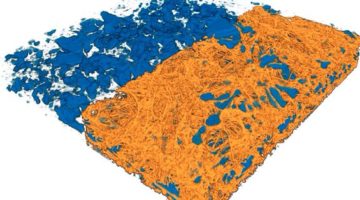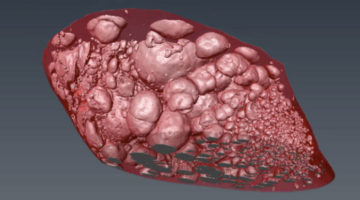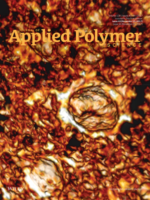A new tool lets researchers pinpoint the locations of chemical reactions happening inside batteries in three dimensions at the nanoscale level. Combining ptychography, tomography, and spectroscopy, Nanosurveyor 1 is a multidimensional tool providing novel insight into the design of next-generation batteries and devices. Read more »
ALS Work Using Tomography
Tomography allows 3D imaging of structures inside samples without the need to physically slice them open. A series of images is collected as a sample is rotated, and the raw data is computationally converted into digital sections that can be stacked to reconstruct 3D visualizations of the sample. The very high flux of x-rays and infrared light at the ALS allows collection of high-quality, high-speed 3D images at nanometer or micrometer resolution. Synchrotron tomography also enables photon-energy tuning for element- and chemistry-specific contrast, as well as phase-contrast imaging.
COSMIC Impact: Next-Gen X-Ray Microscopy Platform Now Operational
After a first-year ramp-up for testing and tuning components, COSMIC is now operating at the ALS. The beamline brings together unique capabilities to measure the properties of materials at the nanoscale, and scientific results from its earliest experiments are expected to be published later this year. Read more »
TE Connectivity Uses ALS to Improve Conductive Plastics
TE Connectivity used ALS microtomography capabilities to optimize the material and manufacturing parameters of their conductive plastics to impart good electrical conductivity. Conductive plastics with good electrical properties offer processing and cost benefits over metal alternatives, with applications ranging from automotive to data communications. Read more »
The Microstructure of a Parrotfish Tooth Contributes to Its Toughness
Parrotfish chew on coral, producing hundreds of pounds of sand each year. Mapping the microstructure of parrotfish teeth, scientists found bundles of crystals interwoven like chain mail. The results provide a blueprint for creating ultra-durable materials for mechanical components that undergo repetitive contact, movement, and abrasion. Read more »
X-Rays Reveal the Biting Truth About Parrotfish Teeth
A parrotfish’s hardy teeth allow it to chomp on coral all day long, ultimately grinding it up through digestion into fine sand. Researchers wanting to see how the fine crystal structure of parrotfish teeth contribute to their incredible strength were able to visualize the orientation of individual crystals, which showed their intricately woven structure. Read more »
Fuel Cell X-Ray Study Details Effects of Temperature and Moisture on Performance
A specialized type of hydrogen fuel cell requires precise temperature and moisture controls to be at its best. But seeing inside a working fuel cell at the tiny scales relevant to a fuel cell’s chemistry and physics is challenging, so scientists used x-ray-based imaging techniques to study their inner workings. Read more »
Fracture Evolution in Carbonate-Rich Shale
Accurate assessment of the suitability of subsurface rock formations for CO2 containment requires a good understanding of fracture evolution. Researchers combined x-ray microtomography with advanced computer simulations to improve models of fracture development in carbonate-rich shale samples. Read more »![]()
![]()
PepsiCo Explores Future Food Products at the ALS
Global food and beverage giant PepsiCo has been using ALS tomography beamline 8.3.2 to understand more about the chemical structure and behavior of their starch-based snack foods, with the goal of creating a whole new category of snacks that consumers cook at home in their own microwaves. Read more »![]()
In Situ Electrical Resistance and X-Ray Tomography Study of Copper–Tin Polymer Composites during Thermal Annealing
In situ electrical conductivity and x-ray tomography experiments were conducted on a conductive polymer composite containing polyvinylidene fluoride (PVDF) copolymer, copper (Cu), and tin (Sn) during thermal annealing. This study provides detailed insight into the morphological origins of the beneficial effect of thermal annealing on the electrical properties of conductive composites containing low melting metal fillers. Read more »
ALS Gives Intel a Closer Look at Microelectronic Packages
Intel, the world’s largest semiconductor chip maker, has been using the tomography capabilities at the ALS to image their microelectronic packages in 3D at high resolution with short throughput time, providing valuable information for both failure analysis and product development and proving that synchrotrons are an insightful tool for this type of imaging. Read more »![]()
- « Previous Page
- 1
- …
- 3
- 4
- 5
- 6
- 7
- Next Page »









